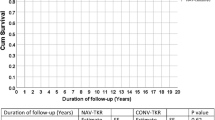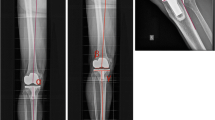Abstract
Purpose
The aim of this study is to investigate the clinical results of total knee arthroplasty (TKA) using a navigation system after a minimum of 5 years.
Method
Thirty cases of posterior-stabilized, TKA-implanted using a computed tomography-free navigation system were compared with 30 cases having matched TKA of the same type implanted via a classical, manual technique. At mid term, a minimum of 5 years after surgery, Knee Society scores (KSSs), Knee Society Functional scores (KSFSs), range of motion (ROM), and radiographic results of 27 patients in each group were assessed and reported in this study.
Results
The accuracy of the implantations in relation to the coronal mechanical axis in the navigation group was superior to that of the manual group (P < 0.01). The femoral rotational profile revealed the prosthesis in the navigation group that was implanted with significantly less internal rotation than the manual group. Mid-term 5-year clinical results, including ROMs and KSSs, were significantly better in the navigation group (P < 0.01). KSFSs were equally good in both the groups.
Conclusion
Better alignment and similarity of good clinical results at mid-term follow up may provide patients who receive navigation TKA with long-term endurance of their implants. Further studies on longer-term outcomes and functional improvements are required to validate these possibilities.
Level of evidence
Prospective comparative study, Level II.

Similar content being viewed by others
References
Bauwens K, Matthes G, Wich M, Gebhard F, Hanson B, Ekkernkamp A, Stengel D (2007) Navigated total knee replacement. A meta-analysis. J Bone Joint Surg Am 89:261–269
Bonutti P, Dethmers D, Stiehl JB (2008) Case report: femoral shaft fracture resulting from femoral tracker placement in navigated TKA. Clin Orthop Relat Res 466:1499–1502
Chung BJ, Kang YG, Chang CB, Kim SJ, Kim TK (2009) Differences between sagittal femoral mechanical and distal reference axes should be considered in navigated TKA. Clin Orthop Relat Res 467:2403–2413
Dutton AQ, Yeo SJ (2009) Computer-assisted minimally invasive total knee arthroplasty compared with standard total knee arthroplasty. Surgical technique. J Bone Joint Surg Am 91(Suppl 2):116–130
Fehring TK, Odum S, Griffin WL, Mason JB, Nadaud M (2001) Early failures in total knee arthroplasty. Clin Orthop Relat Res 392:315–318
Insall JN, Dorr LD, Scott RD, Scott WN (1989) Rationale of the Knee Society clinical rating system. Clin Orthop Relat Res 248:13–14
Jeffery RS, Morris RW, Denham RA (1991) Coronal alignment after total knee replacement. J Bone Joint Surg Br 73:709–714
Jenny JY, Clemens U, Kohler S, Kiefer H, Konermann W, Miehlke RK (2005) Consistency of implantation of a total knee arthroplasty with a non-image-based navigation system: a case-control study of 235 cases compared with 235 conventionally implanted prostheses. J Arthroplasty 20:832–839
Jung YB, Lee HJ, Jung HJ, Song KS, Lee JS, Yang JJ (2009) Comparison of the radiological results between fluoroscopy-assisted and navigation-guided total knee arthroplasty. Knee Surg Sports Traumatol Arthrosc 17:286–292
Kamat YD, Aurakzai KM, Adhikari AR, Matthews D, Kalairajah Y, Field RE (2009) Does computer navigation in total knee arthroplasty improve patient outcome at midterm follow-up? Int Orthop 33:1567–1570
Kanekasu K, Kondo M, Kadoya Y (2005) Axial radiography of the distal femur to assess rotational alignment in total knee arthroplasty. Clin Orthop Relat Res 434:193–197
Kim YH, Kim JS, Yoon SH (2007) Alignment and orientation of the components in total knee replacement with and without navigation support: a prospective, randomised study. J Bone Joint Surg Br 89:471–476
Mahaluxmivala J, Bankes MJ, Nicolai P, Aldam CH, Allen PW (2001) The effect of surgeon experience on component positioning in 673 press fit condylar posterior cruciate-sacrificing total knee arthroplasties. J Arthroplasty 16:635–640
Matsumoto T, Tsumura N, Kurosaka M, Muratsu H, Kuroda R, Ishimoto K, Tsujimoto K, Shiba R, Yoshiya S (2004) Prosthetic alignment and sizing in computer-assisted total knee arthroplasty. Int Orthop 28:282–285
Matsumoto T, Tsumura N, Kurosaka M, Muratsu H, Yoshiya S, Kuroda R (2006) Clinical values in computer-assisted total knee arthroplasty. Orthopedics 29:1115–1120
Minoda Y, Kobayashi A, Iwaki H, Mitsuhiko I, Kadoya Y, Ohashi H, Takaoka K, Nakamura H (2010) The risk of notching the anterior femoral cortex with the use of navigation systems in total knee arthroplasty. Knee Surg Sports Traumatol Arthrosc 18:718–722. PMID: 19784625
Minoda Y, Kobayashi A, Iwaki H, Ohashi H, Takaoka K (2009) TKA sagittal alignment with navigation systems and conventional techniques vary only a few degrees. Clin Orthop Relat Res 467:1000–1006
Molfetta L, Caldo D (2008) Computer navigation versus conventional implantation for varus knee total arthroplasty: a case-control study at 5 years follow-up. Knee 15:75–79
Petersen TL, Engh GA (1988) Radiographic assessment of knee alignment after total knee arthroplasty. J Arthroplasty 3:67–72
Robertsson O, Dunbar M, Pehrsson T, Knutson K, Lidgren L (2000) Patient satisfaction after knee arthroplasty: a report on 27, 372 knees operated on between 1981 and 1995 in Sweden. Acta Orthop Scand 71:262–267
Seon JK, Park SJ, Lee KB, Li G, Kozanek M, Song EK (2009) Functional comparison of total knee arthroplasty performed with and without a navigation system. Int Orthop 33:987–990
Spencer JM, Chauhan SK, Sloan K, Taylor A, Beaver RJ (2007) Computer navigation versus conventional total knee replacement: no difference in functional results at 2 years. J Bone Joint Surg Br 89:477–480
Stulberg SD, Loan P, Sarin V (2002) Computer-assisted navigation in total knee replacement: results of an initial experience in thirty-five patients. J Bone Joint Surg Am 84(Suppl 2):90–98
Tingart M, Luring C, Bathis H, Beckmann J, Grifka J, Perlick L (2008) Computer-assisted total knee arthroplasty versus the conventional technique: how precise is navigation in clinical routine? Knee Surg Sports Traumatol Arthrosc 16:44–50
Author information
Authors and Affiliations
Corresponding author
Rights and permissions
About this article
Cite this article
Ishida, K., Matsumoto, T., Tsumura, N. et al. Mid-term outcomes of computer-assisted total knee arthroplasty. Knee Surg Sports Traumatol Arthrosc 19, 1107–1112 (2011). https://doi.org/10.1007/s00167-010-1361-4
Received:
Accepted:
Published:
Issue Date:
DOI: https://doi.org/10.1007/s00167-010-1361-4




